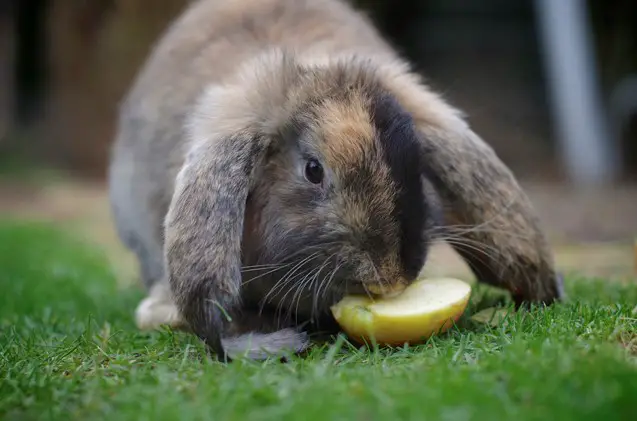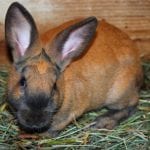Scientific Facts
| Common Name: | German Lop |
| Life Span: | 12 years |
| Size: | Large size |
| Country of Origin: | Germany |

Physical Description
German Lops are energetic rabbits, commonly weighing around 6 to 18 pounds once they are completely grown. They are robust in general, particularly in the rump section, which must also be well-built and short. They have thick and huge ears that hang smoothly down behind their eyes. The ears measure around 11 to 14 inches. Just like other kinds of lops, these creatures have usual length, durable guard hairs, and thick hair fibers. Even though their coats do not need excessive attention to maintain them in excellent condition. Owners will simply run wet hands onto the coat every one-week interval or maximize a slicker brush to eliminate any wandering hairs. They have visible neck and must be proportionately as expansive in the shoulder as the extremities. Their front legs are straight, bulky, and short. The hind legs must be aligned to the rump and not protruding if resting. From a fleeting nape, the back has a line that should surge in a bit curve to a well-muscular rump that should be well-rounded and short. The head is firmly formed with a unique width between the eyes. Their nose is striking. Overall, these creatures are versatile and have a captivating and snuggly look.
There are several color variations of the German Lops. The acknowledged shade groups are: Self (blue, black, blue-eyed white, lilac, ruby-eyed white, and chocolate), Wideband (orange, cream, red, and fawn), Shaded (frosted pearl or smoke, seal, sable, sable point, and tortoise), Ticked (gold tripped, smoke or sable pearl steel, and silver fox), and Agouti (opal, chinchilla, and chestnut agouti).
Lifespan
German Lops have an average lifespan of 12 years. These breeds have a longer lifespan compared to other breeds of rabbits. Hence, raising them as pets is a commitment. Owners should be responsible enough to give proper care to these pets.
Eating Habits
German Lops are characterized as herbivores. Their diet is primarily composed of vegetables, pellets, and hays. Hay is essential for both dental and digestive health. Grass hays like oat, orchard, and timothy may be fed in unlimited volume. Alfalfa, on the other hand, is rich in calories and must, therefore, be provided sporadically.

Sleeping Habits
Naturally, German Lops sleep during the daytime. Dusk and dawn are their main activity periods. When the rabbit is snoozing or relaxed, you will notice it to either lie on its stomach with its back legs extended behind him or lie sideways. These pets may also sleep upright.
Development and Reproduction
Rabbit kits are delivered naked, deaf, and blind. They start to grow hair a few days after they were born. Their ears and eyes are likely to open on the tenth day. These newly born rabbits are not capable of regulating their body temperature until they reach their seventh day. Rebreeding may happen any moment after the delivery.
If a doe is not able to nurture all kits efficiently, the kits may be harbored by taking them out from the nest box on their first 3 days. They are given to a doe of similar age with the same litter. Does only nurse once or twice a day. Kits are detached at around 4 to 5 weeks of their age.
Although kits can be brought up by hand, the rate of death can be relatively high. They must be kept dry, warm, and quiet. Handlers may use a kitten milk substitute, or a mixture of half cup evaporated milk, one tablespoon corn syrup, half cup of water, and one egg yolk. Feedings differ from half teaspoon to two tablespoons, relying on the age. These kits begin feeding greens at about 15 to 18.

How to Breed
Determining the Sexes
Sexes in German Lops are determined by physically inspecting them. Male rabbits have testicles while females do not. Testicles in male rabbits are seen in the middle of the belly and the penis. Females, on the other hand, have a vulva, which is visible in the middle of a convex patch of fur, relatively below the tail.
Courtship and Mating
German Lops become sexually ready at the age of 4 to 4.5 months. The production of eggs among female German Lops is brought about by mating. Opposite to famous belief, rabbits have a rhythm of mating responsiveness. Rabbits are responsive to mating around 14 of every 16 days. Does are most responsive when the vagina is moist and red. However, if the vagina is whitish-pink with minimal to no moisture, does is said to be not responsive to mating.
One way to determine pregnancy is to feel the abdomen of the doe to check for grape-sized embryos occurring in the uterus. The ideal time to perform this is 12 days counting after breeding. However, false pregnancy is rampant in rabbits. Pregnancy commonly lasts around 31 to 33 days.
Eggs and Incubation
The female German Lop can be bred in its 7 to 8 months of age. The total babies every litter reaches from 4 to 8. Does are known to be a great mother.
Common Health Problems
Flystrike
German Lops do not have any specific illness or health problems; nevertheless, they may experience sore hocks if placed in an enclosure with bottoms of wire. If you intend to keep your pet mostly outdoors, be cautious of the flystrike, particularly during the hotter seasons. This happens when the flies lay eggs in the soiled portions of your pet’s coat, and once these eggs hatch, they feed on your pet. This penetration can be agonizing to your pet and may even be fatal. If you notice your rabbit be affected by this attack, make sure to bring your pet to a veterinarian to be given medication.
Overgrown Teeth
Regularly inspect the teeth of your German Lop for disproportionate teeth since the teeth of the rabbit would never stop growing. If the diet of your pet is poor in the hay, its teeth may continue to develop and grow into its jaw and face. Veterinarians may commonly cure any infections brought by overgrown teeth and cut down the teeth to a feasible length.
Ear Mites
Every German Lop must be regularly inspected for ear mites because it is a common issue among rabbits, which are mainly kept outdoors. Ear mites are little bugs that establish shop in the ears of your rabbit. You will notice that the ear will look itchy, brown, and crusty. If you observe your pet scratching its ears often, inspect them. If in case the pet gets penetrated by ear mites, do not be troubled. Your pet is expected to survive it if maintained in a healthy and balanced diet, and the surrounding is clean.
Nevertheless, it is important to note that you should not pick out the scabs from your pet’s ears. These mites will naturally clear up. Picking them out can be painful to your pet and may make them prone to infection. The oil will do this work.
Viral Infections
Just with other little mammals, German Lops are vulnerable to viral infections and colds. Being exposed to draft, stress, and abrupt alterations in temperature may reduce the defiance of the rabbit against sickness.
Snuffles
You need to know that it is not common for a German Lop to get cold. When you notice your rabbit sniffling or having nasal discharges, then you have to exert closer attention to determine what is occurring. Other manifestations of snuffles are watery eyes, sneezing, and matted paws.
Commonly, this illness can be prevented by providing the rabbit with a nutritious diet and keeping the cage clean. Snuffles is a kind of bacteria; hence if you set their immune system prepared to combat while also not allocating a place for the bacteria to grow, then you should be far from worrying about this disease.
Nevertheless, if your German Lop develops this illness, it is commonly best to treat the pet using antibiotics, although there is no guarantee that this will completely treat this disease.
Heat Stroke
You should always pay attention to heatstroke if you intend to raise a German Lop. During the hot season, your pet has to be placed in the shade with plenty of water because heat can rapidly penetrate them. Hence, if your pet is lethargic and the climate outside is warmer, then you will have to do immediate action. Make sure to rapidly lower the body temperature by gently spraying them with cool water. You must bring your pet to a veterinarian so it can be treated using IV fluids.
However, your ultimate bet is to do your best to evade heat stroke by all means. You may do this by providing your pet with frozen water bottles. Your pet can lay near to these bottles and take in some of the coldness. You may also consider blowing a fan in your pet indirectly to allow the cool air to set off around them. Do not directly blow the fan in your pet because it may trigger another problem to your German Lop.
Preventing Illnesses
Several ways can help prevent illnesses in your German Lop. Worming your pet will prevent the little white worms which appear like white flecks in perfectly structured feces. Preventing these worms will greatly help your pet from getting sick because these worms can potentially strip your rabbit its much-required nutrition. It is also important that you maintain cleanliness in the surrounding. Use proper medications before little concerns become a huge one. You may use penicillin injection or Neosporin to inhibit illnesses from gashes.
For babies to be kept alive, utilize a water treatment such as Terramycin powder before coccidiosis penetrates them. It will be wise to do this before manifestations exhibit, as commonly when symptoms show up, there is nothing else that can be done. If you notice plenty of flies in your barn, use some kind of fly killer that is rabbit-safe. Eliminating the flies would imply minimal maggots, minimal foul odors, and less probability of flystrike. It is also significant to remember that if you do not regularly clip the nails, even in a tidy cage, they can still pull or injure the nail and may lead to a noxious infection that directs to toe/nail loss or illness. Bear in mind that bacteria reside anywhere and only waits to be brought in to the bloodstream.
Proper nutrition and exercise also play a vital role in maintaining the health of a German Lop. Healthy rabbits are hardly affected by illnesses.
Behavior
German Lops are gentle and affectionate, which makes them great pets for singles, seniors, couples, and families. They have likable characteristics. They can develop intimate and affectionate bonds with their handlers. Many of them can be taught to use a litter box, will come forward when their name is called, and may even get the pleasure of exploring more tricks. Cohabited with the fact that they are quiet, comparably need small space, and a very minimal odor, it is not difficult to understand why these creatures are very popular pets.
They are very social, inquisitive, and comical creatures and shall live a mournful life if enclosed to a cage with limited interaction. Rabbits also enjoy digging and chewing, and it is particularly significant for their dental prime that they get something suitable to chew on.
Habitat
Enclosure
Whether German Lops are placed indoors or outdoors, their enclosure should have enough space to allow the rabbits to comfortably stretch and loosen up, with a lot of space to move around. When placed outdoors, the enclosures need to have a shield against the affecting elements such as heat, cold, rain, sun, and more. Outdoor enclosures must be inclined from the surface and must have a ramp that directs to the ground to facilitate the roaming of the rabbit. Indoor enclosures, on the other hand, require just as significant space but maybe built of wire, provided that they have a firm bottom. The bottom must be laid through hay, regularly cleaned, and should be entirely replaced every 6 to 8 days. The size of the enclosure must be five times the size of the rabbit. There should be sleeping quarters or a hide-away box for the rabbit to sleep.
Toys
Some owners provide their German Lop some toys to interact with. Cat toys having bells and rattles are famous. The pet will play with them. It will even let you mingle along once it becomes familiar to you.
Diet
The diet of German Lops has no difference with other breeds of rabbits. There should be a 70 percent composition of hay, and the remaining 30 percent should be a superior quality pellets mix, leafy greens, vegetables, and fruits. Fresh pellets must be made available every day. Select a pellet that is rich in fiber and refrain mixes that consist of other foods such as dried fruit, seeds, and corn.
Fresh foods are an essential part of the rabbit’s diet. Dark and leafy greens such as spring greens, romaine lettuce, kale, and some spinach should consist of around 75 percent of the fresh foods provided to the rabbit every day, with servings of vegetables such as summer squash, cauliflower, broccoli, and bell pepper comprising the other 25 percent. Fruits, as well as stuffy vegetables, must be bounded in the diet; however, make impressive treats. See to it that all fresh foods are properly washed. Uneaten foods must be taken out every end of the day.
German Lops also need fresh water. Freshwater must be available at all times, either in a water bowl or in a sipper bottle.
How to Care for German Lop
You should always be mindful of temperature alterations as well as local predators. If your pet is spending much of its time indoors, see to it that you remove it from its enclosure as soon as you arrive home. This will give your pet time to explore its environment in a rabbit-safe room. Before you get a German Lop, you should think first on where it is about to live. These creatures can do great when kept in a hutch outdoors, although any kind of hutch must be waterproof and weather-safe and should be away from direct sun and wind. If you can position the hutch in a place that is properly lit and ventilated shed, then this would be great.
To make sure that they are appropriately socialized, these rabbits should spend at least 4 hours a day to be out from their enclosure. They should be allowed to delve into their environments and also motivate interaction with a human, whether they are kids or strangers. Although any handler must be familiar with the proper conservation as well as the proper caring of a rabbit, the German Lop is an ideal rabbit, to begin with, because of its calm personality and its manageable size.
German Lops are agitated because they are prey creatures; hence, all new pets must be permitted to familiarize the company of humans while they are at their young age. It is necessary to adapt how to properly hold and carry this rabbit because they may get startled and wrestle if they sense danger or if they feel uncomfortable. Considering that they bear massive weight at the end of their hind, if the rear is not properly supported and they feel defenseless, they may startle and wrestle, which may lead to spinal injuries.
Rabbits also get the advantage of having a company. Hence, it may be good to consider getting two rabbits, preferably one neutered male and one female or two neutered males. Never consider housing your German Lop together with a guinea pig because the bigger animal may inflict harm to the little rodent. If your pet is going to stay in your house, it should be trained to use a litter tray. The pet should also be provided with a safe place such as a dog crate or indoor cage where it can proceed to relax. Make sure to keep the wires and cables. Droppings must be taken out every day.
German Lops require space and freedom to explore and exercise, and you will need to ensure that space is rabbit-proofed against gnawing and nibbling. A rabbit that is kept individually shall require plenty of time and affection from its handler, although human accompaniment can never replace the interaction they can get from other rabbits.
Availability – Where to Get One
German Lops would make a great pet. If you are determined to get one now, you must know how to buy one. If you have other options, do not buy your pet from a pet store. Rabbits coming from pet stores mostly came from mass-breeding amenities. Preferably, get your German Lop from a rescue group or a local animal shelter. The personnel in rescue groups or local animal shelters are likely to possess intensive knowledge about caring for a rabbit. You may also consider getting your soon-to-be pet from a credible rabbit breeder.
FAQs
Should I let my kids raise a German Lop?
German Lop can be unideal for kids. Although these creatures are known to be gentle and cute, they may easily get scared and stressed around blaring noises and movements. These pets may not take the pleasure of being cuddled or held and may kick or bite to escape.
Is it okay to keep my German Lop indoor?
German Lops can be kept indoors, either in a free-range or in a cage. These animals are easily litter trained.
Why is it that my German Lop seems to be assertive towards me?
Females are sometimes territorial, particularly over their sleeping area and litter tray. It is advised that you avoid annoying your German Lop while she is in the tray. You can clean it out once it is not looking. You may also consider the fact that the assertiveness of your pet can be related to fear and apprehension, perhaps your pet had an unfortunate experience before, and its confidence to humans has been broken. Exert more effort and patience to gain back its trust.

